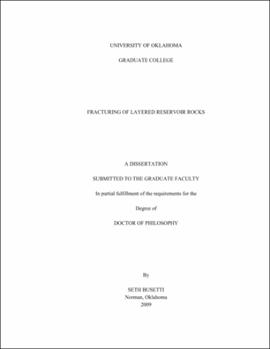| dc.contributor.advisor | Reches, Ze'ev | |
| dc.creator | Busetti, Seth | |
| dc.date.accessioned | 2019-04-27T21:22:49Z | |
| dc.date.available | 2019-04-27T21:22:49Z | |
| dc.date.issued | 2009 | |
| dc.identifier | 99139913402042 | |
| dc.identifier.uri | https://hdl.handle.net/11244/318541 | |
| dc.description.abstract | The development of fractures in rock layers reflects a history of complex, non-linear, time-dependent mechanical processes. The processes strongly depend on the rock rheology, particularly the behavior during progressive deformation, layering effects such as the mechanical stratigraphy, and the local stress conditions. In the past, the complex mechanics associated with fracture initiation and propagation contributed to the application of simplified models based on linear rheology and using quasi-static solutions. While this approach is effective in solving infinitesimal strain problems, it provides no explanation for strain localization, damage accumulation and rock failure, and it oversimplifies fracture propagation. The objective of the present work is to contribute to the understanding of these processes. | |
| dc.description.abstract | The approach of this study is as follows. (Chapter 1) Theoretical advancements on fracturing and the concept of continuum damage mechanics are compared with rock mechanics experiments to understand progressive deformation, failure, and fracture propagation for rock. It is demonstrated that non-local (away from the crack-tip) yielding behavior must be considered to understand complex fracturing. (Chapter 2) A numerical rheology based on the elastic-plastic-damage properties of Berea sandstone is developed and calibrated to experimental rock mechanics data. A method for translating the stress-strain curve and acoustic emissions data into a material model included in the commercial finite element code Abaqus is presented. Two rock mechanics experiments are simulated in 3-D to test the rheology model. (Chapter 3) The rheology is implemented into finite element models based on classical hydraulic fracturing configurations. The explicit dynamic finite element method is used to simulate damage and transient propagation of a hydrofracture segment. It is shown that the complexity of fracturing depends on the local stress-strain response, which is controlled by the evolving damage pattern. The dynamical characteristics of arrest, rupture, branching, and segmentation of the fracture are described in terms of damage evolution. (Chapter 4) An analytical model for natural fracture reactivation is paired with the finite element simulations to understand the development of complex hydraulic fracture networks in the subsurface. The models' predictions are compared with data from hydraulically stimulated wells in the Barnett Shale. Recommendations are made for optimizing hydrofracture operations in wells for different states of stress (Chapter 5). The occurrence of zones of anomalously high fracture density is characterized in a carbonate sequence near Cedar Mountain Utah, and in Jackfork Group sandstone layers in Oklahoma and Arkansas. The results indicate that fracture density should be examined as a function of the evolving rock properties of the host layer in addition to the layer thickness. | |
| dc.description.abstract | The investigation contributes to understanding the process of damage and fracturing during the deformation of rock layers. The results describe the development of mechanical inhomogeneity in fractured rock layers and can be applied to explain the formation of complex hydraulic fractures in unconventional reservoirs. | |
| dc.format.extent | 271 pages | |
| dc.format.medium | application.pdf | |
| dc.language | en_US | |
| dc.relation.requires | Adobe Acrobat Reader | |
| dc.subject | Hydraulic fracturing | |
| dc.subject | Rheology | |
| dc.subject | Rocks--Fracture | |
| dc.subject | Shale--Texas--Fort Worth Basin | |
| dc.title | Fracturing of Layered Reservoir Rocks | |
| dc.type | text | |
| dc.type | document | |
| dc.thesis.degree | Ph.D. | |
| ou.group | Mewbourne College of Earth and Energy::ConocoPhillips School of Geology and Geophysics | |
